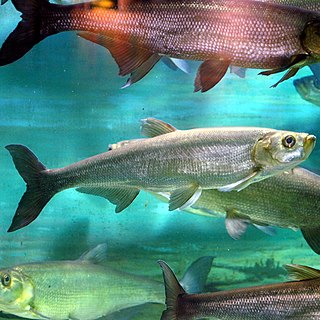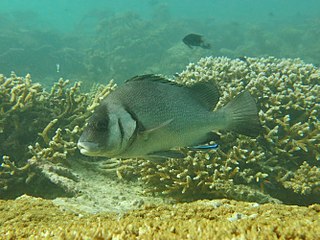
The longfin catshark is a shark of the family Pentanchidae. This shark is found in the western Pacific from Japan to the Philippines, and the East and South China Seas, and the Kyūshū-Palau Ridge, at depths between 530 and 865 m. Its length is up to 48 cm.

Chanodichthys is a genus of freshwater ray-finned fishes belonging to the family Xenocyprididae, the East Asian minnows or sharpbellies. The species in this genus are found in Eastern Asia. The name is derived from the Greek word chanos, meaning "abyss, mouth opened, inmensity", and the Greek word ichthys, meaning "fish". Chanodichthys is closely related to Culter and some species have been moved between these genera.
George Sprague Myers was an American ichthyologist who spent most of his career at Stanford University. He served as the editor of Stanford Ichthyological Bulletin as well as president of the American Society of Ichthyologists and Herpetologists. Myers was also head of the Division of Fishes at the United States National Museum, and held a position as an ichthyologist for the United States Fish and Wildlife Service. He was also an advisor in fisheries and ichthyology to the Brazilian Government.
Haplochromis brownae is a species of cichlid endemic to Lake Victoria though it may be extinct in the wild. This species can reach a length of 10.4 centimetres (4.1 in) SL. The identity of the person honoured by this species' specific name is not known but it is thought most likely to be Margaret “Peggy” Brown (1918-2009) who was a visiting scientist with the East African Freshwater Fisheries Research Organization at Jinja, Uganda in 1950 or 1951, where Humphry Greenwood was working.
Haplochromis michaeli is a species of cichlid endemic to Lake Victoria. It is critically endangered, thought it may now be extinct. This species can reach a length of 14.5 centimetres (5.7 in) SL. The specific name honours the collector of the type, the British fisheries scientist Michael Graham (1888-1972).

Haplochromis sauvagei is a species of cichlid endemic to Lake Victoria. This species reaches a length of 10.5 centimetres (4.1 in) SL. Its specific name honours the French paleontologist and ichthyologist Henri Émile Sauvage (1842-1917).
Haplochromis worthingtoni is a species of cichlid endemic to Lake Kyoga in Uganda. This species reaches a length of 14.1 centimetres (5.6 in) SL. The specific name honours the explorer E. Barton Worthington (1905–2001) who collected the type of this species with type with Michael Graham.

The flasher scorpionfish, or rough humpback scorpionfish is a species of venomous marine ray-finned fish belonging to the family Scorpaenidae, the scorpionfishes. This species is found in the western Pacific Ocean.
Paramphilius teugelsi is a species of loach catfish found in Guinea and Sierra Leone in the Mamou and Kogon Rivers. It grows to a length of 5.1 cm.
Hemiculter krempfi is a species of ray-finned fish in the genus Hemiculter. It is known only from the Cai River in Khanh Hoa Province and the Da Rang River in Phu Yen Province of central Vietnam. Here it is found mainly over sand substrates and is infrequently encountered in fish markets.

Leptobarbus hosii, the Sayan Barb, also locally called as Piam and Temopong, is a species of ray-finned fish in the genus Leptobarbus from freshwater habitats in northern Borneo in southeast Asia. However, a previously unknown population has been recorded in West Kalimantan.
Claea dabryi is a species of stone loach endemic to the Jinshajiang river basin in China. Commonly known as 戴氏南鰍, which translates as Dai's southern loach.
Lampiella gibbosa is a species of armored catfish endemic to Brazil where it is found in the Ribeira de Iguape River basin. This species is the only recognized member of its genus. This species grows to a length of 5.0 centimetres (2.0 in) TL.

The humpback red snapper, the paddletail, paddletail snapper or hunchback snapper, is a species of marine ray-finned fish, a snapper belonging to the family Lutjanidae. It has a wide Indo-West Pacific distribution. It is a commercially important species, as well as being sought after as a game fish. It is also a popular species for display in public aquaria. It has been reported to cause ciguatera poisoning.

Plectorhinchus gibbosus, commonly known as the Harry hotlips, black sweetlips, brown sweetlips, dusky sweetlips, gibbous sweetlips, hairy hotlips or humpback sweetlips, is a species of marine ray-finned fish, a sweetlips belonging to the subfamily Plectorhinchinae, one of two subfamilies in the family Haemulidae, the grunts. It is native to the Western Pacific and Indian Oceans.
Canna Maria Louise Popta was a Dutch biologist.
Gnathopogon nicholsi is a species of ray-finned fish in the genus Gnathopogon endemic to the Yangtze River basin in China.
The Chinese lizard gudgeon is a species of cyprinid fish found in the Amur basin to the Pearl River in China, Mongolia and the Korean peninsula. It is also found in Vietnam.

Squalidus wolterstorffi is a species of cyprinid fish endemic to southeastern China.

The humpbacked scorpionfish is a species of venomous marine ray-finned fish belonging to the family Scorpaenidae, the scorpionfishes. This species is found in the western Indian Ocean.









